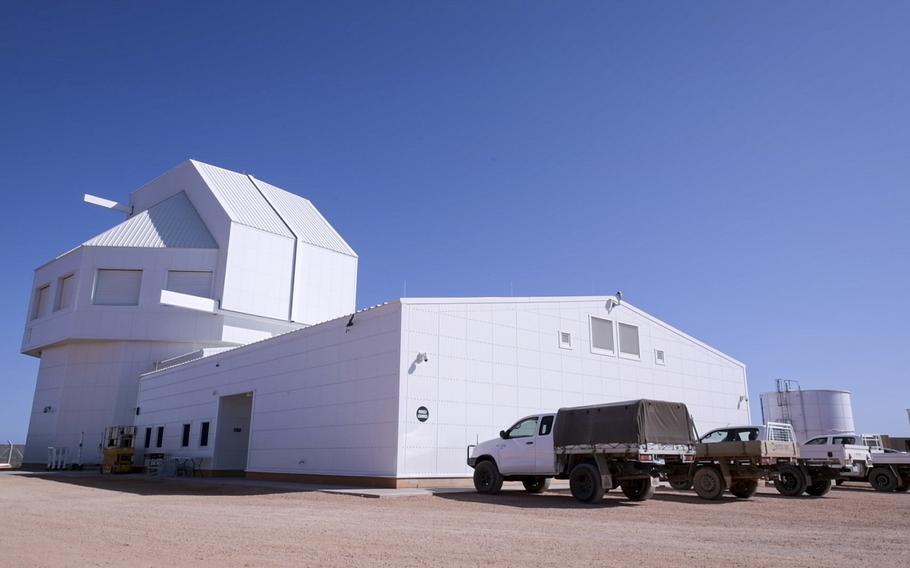
The Space Surveillance Telescope, developed by the U.S. Defense Advanced Research Projects Agency, is being reassembled at NCS Harold E. Holt, near Exmouth, Australia. The Exmouth region is also the site of the new Deep-Space Advanced Radar Capability system. (Petty Officer 2nd Class Jeanette/U.S. Navy)
(Tribune News Service) — Colorado Springs is playing a key role in a new radar system that will track objects about 22,000 miles above Earth — an orbit home to satellites that provide critical services such as telecommunications.
Northrop Grumman’s Colorado Springs office started work on the system after the company received the initial $341 million contract in 2022 focused on the first of three sites for the new Deep-Space Advanced Radar Capability system, known as DARC. In August, the company won another $200 million contract for the second site.
The first site is on the northwest coast of Australia near Exmouth, the second site is planned for Pembrokeshire, Wales, and the final site will be in the U.S. The three host nations will operate the arrays together, and a Space Force news release said, all three are scheduled to be operational by the end of the decade.
Telescopes provide some of the tracking of objects in geosynchronous orbit, about 22,000 miles above the Earth, and so they are limited by the sun and clouds. The “game-changing” radar system won’t have those limitations, explained Colorado-Springs based Kevin Giammo, director of the space surveillance and environmental intelligence operating unit. The system will operate 24/7, no matter the weather.
Space Command’s leader Gen. Stephen Whiting touted the DARC system in a recent panel appearance, noting while the U.S. has the best space domain awareness in the world, DARC is one of the exciting upcoming improvements, along with new on-orbit systems. Space domain awareness is the ability to predict and detect threats, and determine who is responsible for them.
Space has become much more contested in recent years, with both Russia and China investing heavily in space. The perhaps most high-profile potential threat is Russia’s work to launch a nuclear weapon into space.
The work on the new radar system has been ongoing for over decade with the Space Force and Johns Hopkins Applied Physics Laboratory announcing a successful test in 2021. The small-scale demonstration used dish antennas to track objects in space at White Sands Missile Range. It showed the system’s ability to “detect small space objects or satellites quickly and with highly precise orbital information,” according to the lab.
Satellites in geosynchronous orbit travel at the same rate as the Earth and stay above the same position on the surface. Three satellites in this orbit can provide a view of the whole Earth, according to the European Space Agency.
When North Grumman won the contract for the first phase in 2022, it staffed up, hiring about 100 people locally and others at the construction site and elsewhere.
Colorado Springs employees lead the effort and meet with military officials on the project, Giammo said. The company employs about 1,200 people in town and locally specializes in space domain awareness, communications, and missile warning, Giammo said. He doesn’t expect any major additional hiring for the next phase of the contract.
The first site in Western Australia is busy right now with construction underway, Giammo said. In a December 2023 statement from the DOD, officials said the site would be operational in 2026.
Northrop Grumman expects to see efficiencies in their upcoming work because of similarities between the sites in Australia and Wales, he said.
A news release from the United Kingdom’s Ministry of Defense said Cawdor Barracks in Wales would be redeveloped for the new radar site. The new mission would employ about 100 people on the site previously used by the Royal Air Force and Royal Navy. The Guardian reported that 27 radar dishes are planned for the site.
Once all three sites are complete, Northrop Grumman expects to work on the maintenance and sustainment of the system, Giammo said.
In addition to Northrop Grumman’s recent success, the Colorado Springs defense industry is expecting other healthy gains with companies like Zivaro, Intuitive and others planning expansions.
“This is an exciting time to be in our industry, especially in the space business,” Giammo said. “We will be proud to be a part of that future for the decades to come here in Colorado Springs.”
(c)2024 The Gazette.
Visit The Gazette at www.gazette.com.
Distributed by Tribune Content Agency, LLC.